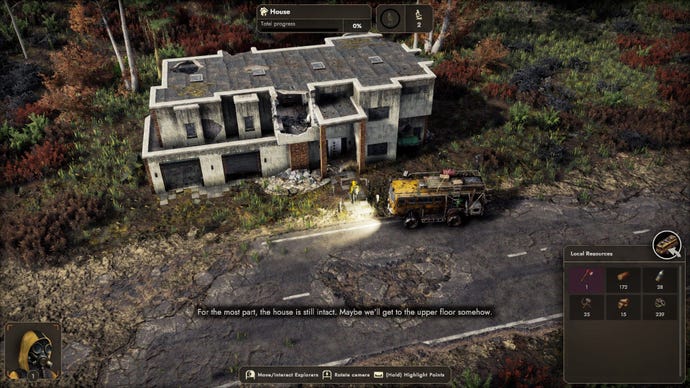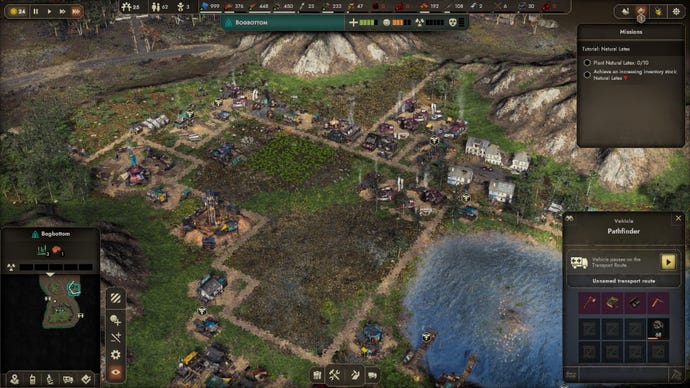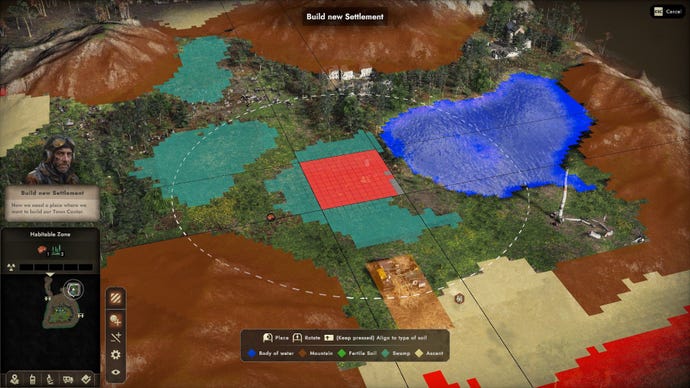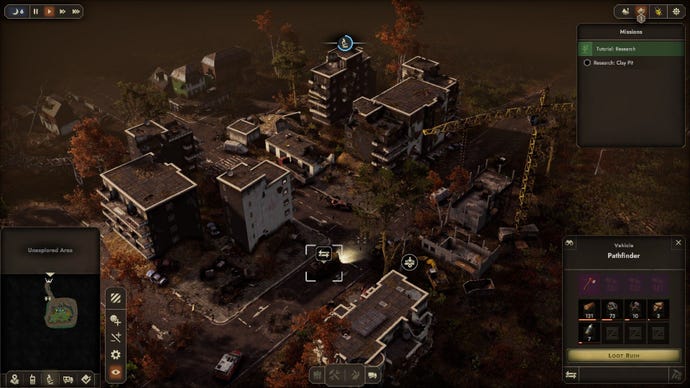Endzone 2 early access review: rebuild humanity as a post-apocalyptic plate-spinner
Drought's a-comin'
Sometimes you forget to build a graveyard. It happens. When ten citizens dropped dead on the roads of one of my settlements in post-apocalyptic city builder Endzone 2, I had to work fast to avoid a sickness breaking out. But graveyards require a lot of space, and if you've already filled your shanty town with a sea of corrugated metal roofs, this poses a problem. Welcome to the pleasant headache of town planning in a post-nuclear world, where most of the land is brown and uninhabitable.
Endzone 2 conforms to a lot of expectations when it comes to building games, although it does have a small side hustle in CRPG-style scene exploration (more on that in a bit). You play a band of underground survivors repopulating the surface. But the resentful earth dictates your use of space, with little red squares of swamp or mountain or lake or wasteland refusing to conform to your desire for more housing, or a market in the otherwise perfect spot. The resulting townships often feel organic and real, rather than the endless rows of apartments or perfectly round suburbs that might be permissible in other building games.
There are plenty of building types to plop down and plenty of workers to assign. Little unseen fishermen will add to your food stash, little invisible weavers will increase your stack of fabrics. Many buildings get bonuses for being near others of a certain type. A coal furnace near a lumberjack's shack, for example. A storage depot near... uh, anything. But since you are sometimes forced to squeeze stuff together in awkward ways, you'll often have to abandon hopes for a perfect level of output. This, I think, is the game's quiet appeal. It's about efficiency, sure, about clicking the knobs of a machine back and forth. but it's a machine that doesn't want to accommodate you all the time. It says: "Look, this is how things are in the deadlands, deal with it."
There are moments of seasonal peril that require you to stockpile goods for difficult moments. A drought causes lakes to completely vanish, and your water supplies to dwindle rapidly. Toxic rain demands protective clothing, or radiation sickness will befall your frontiersfolk. It definitely subscribes to the "ant vs grasshopper" school of building games wherein the tension comes from wanting to expand while also squirrelling away bags of grub for successive crises (hello Banished, hello Northgard, hello Timberborn). So there is some level of ongoing threat. But aside from this tension I found the whole thing strangely relaxing.

Maybe that's because, at any time, you can leave the workshops ticking over and go on a road trip. A toylike truck offers Endzone 2's side gig in scavengey adventuring. You guide the truck along the cracked roads of the garbage future, looting various ruins for extra resources. Some locations allow your drivers to hop out of the vehicle and explore the surroundings, interacting with objects from an isometric perspective in an almost CRPG style. Find an axe and force open some doors. Discover a book that will help you identify plants, thus unlocking new seeds to farm. Blowtorch open a shipping container and scoop out all the iron ingots inside, like a child in an irradiated yellow raincoat cracking open a long-lost Kinder egg.
This is also how you advance up the game's research tree. By exploring these urban dives and roadside dumping grounds (sometimes quite far from your settlement) you gain "knowledge points" that allow you to work your way down a traditional tech tree of mines, water treatment plants, bathhouses, crematoriums, not to mention plenty of upgraded versions of the same buildings you already own.
It's a nice distraction, and linking it to the research tree makes it feel important to indulge in an outing now and again. That said, Endzone 2 is first and foremost a game of checking in on green arrows and dispelling red arrows with judicious meter tweaking and on-the-hoof construction projects. This becomes clear once you use that same little exploration truck to establish whole new settlements on the same big map, at which point the plate spinning begins in earnest.

Each small zone of green and habitable land that you discover will have distinct strengths and weaknesses. One settlement might get a lot of fresh water from many lakes, great for keeping a cloth industry thriving. Another will be in the swamp, well-suited for making medicinal herbs. Another might boast a seam of iron to capitalise upon, or an iodine mine. Since each village on your wider map will come to specialise in these specific goods, you then have to set up transport links, again using the road trip trucks as lil' lorries, nipping back and forth between your towns with their boots full of syringes or rubber gloves or clay bricks or gas masks.
In time, a small network of goods starts to form. Interdependent chains of productions arise, and you might start to try to optimise things. Workshops will produce tools faster if there is a scrapyard and a woodcutter's lodge nearby to provide materials, and fisheries will gather more seafood when those toolmaking workshops are placed nearby. It's a fairly standard base-building process of creating multiple towns with criss-crossing logistical needs. The challenge comes in placing these buildings when the terrain doesn't allow for perfect efficiency, or when the haphazard decisions you made previously have created a sprawl that makes new building placement its own puzzle. Folks, do we really need a graveyard?
When a sudden drought or a blast of illness sweeps through the landscape and threatens the stability of your provincial paradises, you end up tweaking those import-export routes in micro-managey ways, trying to ensure that Grimdork Lakes gets enough medicine from other towns, or that plenty of water is delivered to Garbageville (yes, you can rename your settlements). When toxic storms strike, a little geiger meter shows how much radiation your settlers are getting exposed to. And you have to keep an eye on the soil as well, because it too can become poisoned with radiation.




If the sound of the geiger doesn't unsettle you, the rickety voice acting might. The music too feels very placeholder. The synthwave soundtrack, while not obnoxious in and of itself, doesn't pair well with the art style or subject matter. It's the kind of music you hear in sci-fi space games, an almost robotic beat that might fit if this were a base-building game set in a twinkling cyberpunk city ruin. But against the bucolic backdrops and overgrown country houses it creates a strange clash of ambience. I turned this music down to 0% and put on a "chill guitar" playlist instead. It works a little better.
I have other misgivings. For a game about efficiency and chains of production, there is sometimes unnecessary friction. The long loading times when resuming your save file will hopefully shake out in early access. As for other stuff, I don't know. A pharmacist and a pharmacy are two different buildings you can create, for example - one to make drugs and another to distribute them. Not only do the similar names cause confusion, it also feels like overkill in a society that has to cut corners by nature. Can't one building do both?
There are other restrictive quirks. For instance, since each settlement has its own pool of resources, you need to toggle between towns, opening the research tree in each one before finding the settlement with enough iron or glass or whatever to punch the "research" button on a particular piece of tech. This also means you sometimes have to funnel a meagre handful of clay or meds or clothes to where they are necessary, just to press a button, when your logistics brain is busy shouting "I already have all the things I need!".

In general, this is why research and skill trees in games often operate on their own separate currency - it ringfences them from problems like this. But the research tree of Endzone 2 requires not only knowledge points, but also worldly goods. This makes it more rooted to your production and transport network, yes, but also results in these sometimes unintuitive moments. It is, at times, a slow game, even on its fastest-forwardedest setting.
For those who prefer their logistical twiddling to be more abstract and neat, this isn't going to tear you away from the factory lines of Shapez 2. But it might be worth a pop for those who prefer their number-fiddling to be wrapped up in a thematic purpose. It doesn't have the moral compassing nor the defined flavour of Frostpunk (which, for me, remains the more eye-catching post-apocalyptic city builder). But it does enough with its humble scavengers and salvaging expeditions to at least invest you in the populace as a whole. Even if that concern is always attached to a selfish desire to avoid resources plummeting.
"Oh no, the residents of Bogbottom are being lashed with acid rain again," you'll say to yourself. "This will slow down vaccine production." Better get digging now, those bodies won't bury themselves.


